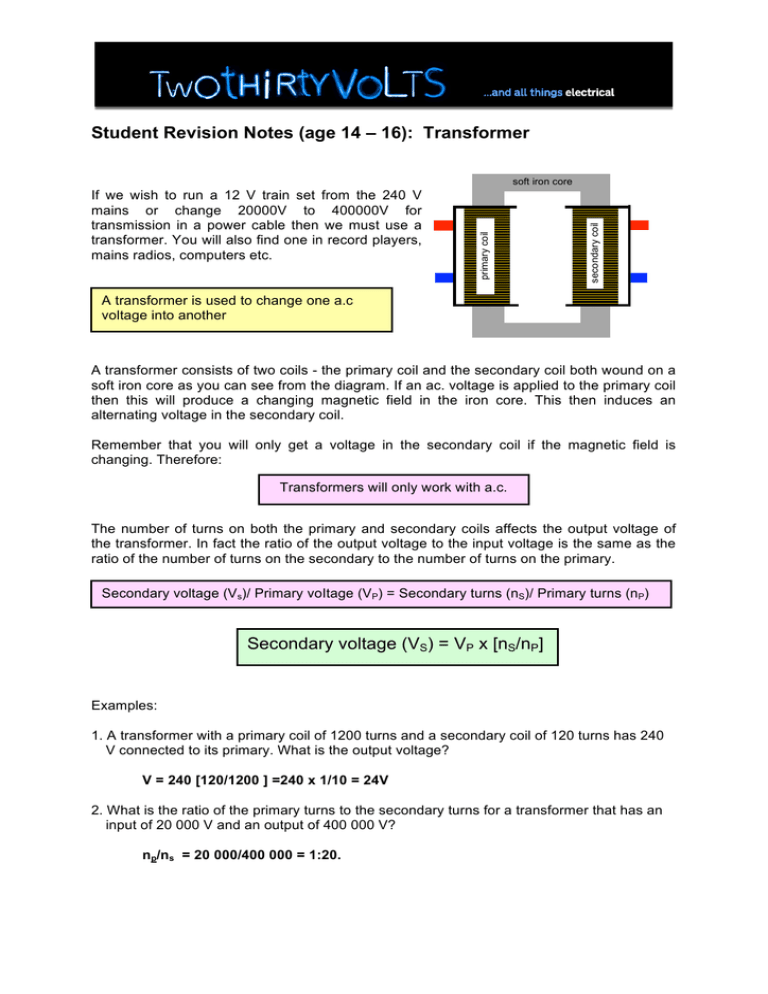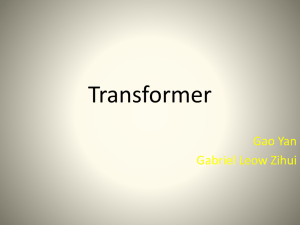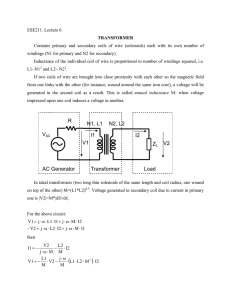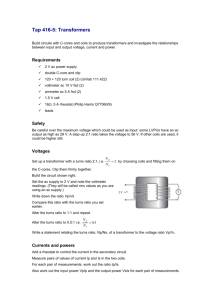Revision Notes - Two Thirty Volts
advertisement

Student Revision Notes (age 14 – 16): Transformer secondary coil primary coil soft iron core If we wish to run a 12 V train set from the 240 V mains or change 20000V to 400000V for transmission in a power cable then we must use a transformer. You will also find one in record players, mains radios, computers etc. A transformer is used to change one a.c voltage into another A transformer consists of two coils - the primary coil and the secondary coil both wound on a soft iron core as you can see from the diagram. If an ac. voltage is applied to the primary coil then this will produce a changing magnetic field in the iron core. This then induces an alternating voltage in the secondary coil. Remember that you will only get a voltage in the secondary coil if the magnetic field is changing. Therefore: Transformers will only work with a.c. The number of turns on both the primary and secondary coils affects the output voltage of the transformer. In fact the ratio of the output voltage to the input voltage is the same as the ratio of the number of turns on the secondary to the number of turns on the primary. Secondary voltage (Vs)/ Primary voItage (VP) = Secondary turns (nS)/ Primary turns (nP) Secondary voltage (VS) = VP x [nS/nP] Examples: 1. A transformer with a primary coil of 1200 turns and a secondary coil of 120 turns has 240 V connected to its primary. What is the output voltage? V = 240 [120/1200 ] =240 x 1/10 = 24V 2. What is the ratio of the primary turns to the secondary turns for a transformer that has an input of 20 000 V and an output of 400 000 V? np/ns = 20 000/400 000 = 1:20. If the number of turns on the primary is greater than that on the secondary then the voltage on the secondary will be less than that on the primary If there are more turns on the secondary the output voltage will be larger. If the secondary voltage is less than the primary voltage, the transformer is known as a STEP-DOWN transformer. If the secondary voltage is greater than the primary voltage it is known as a STEP-UP transformer. A voltage change from primary to secondary will mean a current change also. If the voltage is increased the current will be decreased and vice versa. So a 20:1 step-down transformer for voltage will be a 20:1 step-up transformer for current. Bigger currents need thicker wire and so step down transformers have primary coils of thin wire and secondary coils of thick wire. Examples of step up and step down transformers (a) Step down: electric mains clock, stereo, substation, low voltage power supplies, and audio systems in televisions. (b) Step up: power station end of transmission cables, electron gun in a TV, “starter” coils in fluorescent lights. Energy losses in a transformer These formulae are only correct if the transformer is 100% efficient but of course they never are. Energy is always lost and so the output voltage will be a little smaller than the calculated value. Energy can be lost as: (a) Heat in the coils because of the resistance of the wire; (b) Incomplete transfer of magnetic field; (c) Heating of the core due to induced currents in it. This is reduced by making the core out of insulated soft iron in laminated strips. If this were not done the cores of large transformers would get so hot that they would melt. Linked Resources www.twothirtyvolts.org: Transformer (14-16) Student Quiz





